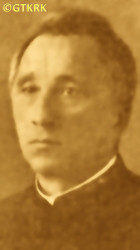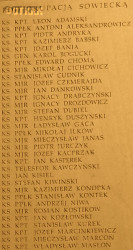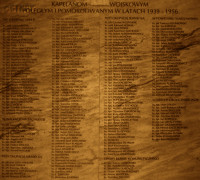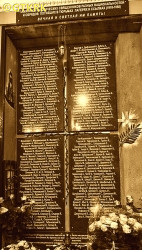Roman Catholic
St Sigismund parish
05-507 Słomczyn
85 Wiślana Str.
Konstancin deanery
Warsaw archdiocese, Poland
full list:
displayClick to display full list

searchClick to search full list by categories
wyświetlKliknij by wyświetlić pełną listę po polsku

szukajKliknij by przeszukać listę wg kategorii po polsku

Martyrology of the clergy — Poland
XX century (1914 – 1989)
personal data
surname
BOGUCKI
forename(s)
Charles (pl. Karol)
function
diocesan priest
creed
Latin (Roman Catholic) Church RCmore on
en.wikipedia.org
[access: 2014.09.21]
diocese / province
Lviv archdiocesemore on
en.wikipedia.org
[access: 2013.05.19]
RC Military Ordinariate of Polandmore on
en.wikipedia.org
[access: 2014.12.20]
honorary titles
Rochettum et Mantolettum canonmore on
Rochettum et Mantolettum canon
(1922)
Expositorii Canonicalis canonmore on
Expositorii Canonicalis canon
(30.03.1910)
date and place
of death
11.02.1942

ITL KarLagGuLAG slave labour camp network
today: n. Karaganda, Karaganda reg., Kazakhstan
more on
en.wikipedia.org
[access: 2019.10.13]
alt. dates and places
of death
27.01.1942, 05.1941, 06.1941
Khersontoday: Kherson urban hrom., Kherson rai., Kherson obl., Ukraine
more on
en.wikipedia.org
[access: 2022.08.05]
details of death
During World War I, in the years 1914‐1916, chaplain of the 11th Infantry Division of the army of the Austro–Hungarian Monarchy. The division took part in the fighting in Galicia. In 1914, it withdrew under the pressure of Russian troops of General Brusilov to the Carpathian line After the Battle of Gorlice on 02–05.05.1915 and the breakthrough of the Russian front, it took part in pushing the Russians beyond the borders of Galicia and to the eastern borders of Belarus.
After being nominated on 01.11.1916 as a senior chaplain, transferred to the Austrian Germ. Militärgeneralgouvernement in Polen (Eng. General Military Government in Poland), to the Kielce garrison.
From 04.11.1918 chaplain of the Polish Army (initially formed by the Regency Council of the German–Austrian Kingdom of Poland, and from the end of World War I on 11.11.1918 by the reborn Polish state).
Participant in the Polish–Russian War of 1919‐1921. Sources are inconsistent. According to some, was a chaplain of a military hospital in Lviv, which the Russians — during the invasion that ended on 15.08.1920 with the Russian defeat in the Battle of Warsaw (known as the „Miracle on the Vistula”) — failed to capture in 08.1920. According to others, was a dean at the Command of the „Lublin” Military District in Lublin, which was also bypassed by the Russian invasion.
After German and Russian invasion of Poland in 09.1939 and start of the World War II, after start of Russian occupation, arrested by the Russians in 09.1939 in Brody.
Released after intervention of his local Jewish acquaintances who collaborated with Russians.
Despite friendly warnings and advice did not leave Brody and did not attempt to cross over to German–occupied Germ. Generalgouvernement (Eng. General Governorate).
Then on 09.04.1940 arrested again by the Russians.
Held in Zolochiv prison.
Accused of „involvement in anti working class and revolutionary movement activities while fulfilling and important position”.
Prob. sentenced „formally” to Russian slave labour concentration camps — Gulag.
Brought to Lviv, thence sent to Kherson prison.
Next on 29.06.1941 — a few days after the German on 22.06.1941 attack on its erstwhile ally, the Russians, and the panicky withdrawal of the Russians from the occupied territories — transported to ITL KarLag n. Akmolinsk (today: Astana) in Kazakhstan.
There after a few months of slave labour moved to „camp's sick room” where perished.
Russian „camp's specialists” recorded: „heart stoppage”.
alt. details of death
Perished in prison.
cause of death
extermination
perpetrators
Russians
sites and events
ITL KarLagClick to display the description, GulagClick to display the description, KazakhstanClick to display the description, GeneralgouvernementClick to display the description, Ribbentrop‐MolotovClick to display the description, Pius XI's encyclicalsClick to display the description, Polish‐Russian war of 1919‐1921Click to display the description
date and place
of birth
26.01.1868

Maly Filvarkytoday: part of Brody, Brody urban hrom., Zolochiv rai., Lviv obl., Ukraine
more on
uk.wikipedia.org
[access: 2022.08.05]
parents
BOGUCKI Joseph
🞲 ?, ? — 🕆 ?, ?

HUSARSKA Anastasia
🞲 ?, ? — 🕆 ?, ?
presbyter (holy orders)
ordination
16/23.07.1893

positions held
1938 – 1940
resident — Brodytoday: Brody urban hrom., Zolochiv rai., Lviv obl., Ukraine
more on
en.wikipedia.org
[access: 2020.11.20] ⋄ Exaltation of the Holy Cross RC parish ⋄ Brodytoday: Brody urban hrom., Zolochiv rai., Lviv obl., Ukraine
more on
en.wikipedia.org
[access: 2020.11.20] RC deanery — retired (decommissioned)
1929 – 1938
chaplain — Lvivtoday: Lviv urban hrom., Lviv rai., Lviv obl., Ukraine
more on
en.wikipedia.org
[access: 2022.01.16] ⋄ monastery, Benedictine Nuns OSB — also: prefect at Benedictine Nuns OSB Gymnasium
31.05.1929
decommissioning — Polish Armed Forces
1928 – 1929
RC military dean — Poznańtoday: Poznań city pov., Greater Poland voiv., Poland
more on
en.wikipedia.org
[access: 2021.07.18] ⋄ Command of the Corps District DOK No. VII Poznań, Polish Armed Forces — also: member of the Audit Committee of the Bishop's Curia of the Polish Army
1923 – 1928
RC military dean — Lvivtoday: Lviv urban hrom., Lviv rai., Lviv obl., Ukraine
more on
en.wikipedia.org
[access: 2022.01.16] ⋄ Command of the Corps District DOK No. VI Lviv, Polish Armed Forces
1921 – 1923
RC military dean — Lublintoday: Lublin city pov., Lublin voiv., Poland
more on
en.wikipedia.org
[access: 2021.08.20] ⋄ Command of the Corps District DOK No. II Lublin, Polish Armed Forces
16.12.1921
RC general military dean — Polish Armed Forces — appointment: by decree of the Commander‐in‐Chief, commissioned, verified with seniority from 01.04.1920, with 2nd place among Roman Catholic general deans, in the brigadier general rank
1919 – 1921
RC military chaplain — Lvivtoday: Lviv urban hrom., Lviv rai., Lviv obl., Ukraine
more on
en.wikipedia.org
[access: 2022.01.16] ⋄ Garrison Hospital, Command of the General District DOG „Lviv”, Polish Armed Forces — prob. started on 30.09.1919
1918 – 1919
RC military chaplain — Kielcetoday: Kielce city pov., Holy Cross voiv., Poland
more on
en.wikipedia.org
[access: 2021.06.07] ⋄ Command of the General District DOG „Kielce”, Polish Armed Forces — the Polish army that the so‐called Regency Council of the German–Austrian Germ. Königreich Polen (Eng. Kingdom of Poland) started to form on 27.10.1918 — specifically its Military Inspectorate of Kielce, which next on 17.11.1918 was transformed into the General District Command „Kielce” — prob. joined on 04.11.1918, before the end of World War I and the rebirth of the Polish state (i.e. 11.11.1918)
1916 – 1918
RC military chaplain — Kielcetoday: Kielce city pov., Holy Cross voiv., Poland
more on
en.wikipedia.org
[access: 2021.06.07] ⋄ Austro–Hungarian Imperial Army
01.11.1916
RC senior military chaplain — Austro–Hungarian Imperial Army — promotion and commissioning: prob. in captain rank
1903 – 1916
RC military chaplain — Lvivtoday: Lviv urban hrom., Lviv rai., Lviv obl., Ukraine
more on
en.wikipedia.org
[access: 2022.01.16] ⋄ 11th Corps HQ, Austro–Hungarian Imperial Army — after the outbreak of World War I in 1914, chaplain of the 11th Infantry Division, part of the Army Group of General Hermann Kövess von Kövesshaz
1897 – 1903
vicar — Stanislavivtoday: Ivano‐Frankivsk, Stanislaviv/Ivano‐Frankivsk rai., Stanislaviv/Ivano‐Frankivsk obl., Ukraine
more on
en.wikipedia.org
[access: 2020.11.20] ⋄ Immaculate Conception of the Blessed Virgin Mary RC parish ⋄ Stanislavivtoday: Ivano‐Frankivsk, Stanislaviv/Ivano‐Frankivsk rai., Stanislaviv/Ivano‐Frankivsk obl., Ukraine
more on
en.wikipedia.org
[access: 2020.11.20] RC deanery — also: prefect at Adam Mickiewicz's Secondary School for Boys
1895 – 1897
vicar — ChernivtsiBukovina region
today: Chernivtsi urban hrom., Chernivtsi rai., Chernivtsi obl., Ukraine
more on
en.wikipedia.org
[access: 2020.11.20] ⋄ Exaltation of the Holy Cross RC parish ⋄ ChernivtsiBukovina region
today: Chernivtsi urban hrom., Chernivtsi rai., Chernivtsi obl., Ukraine
more on
en.wikipedia.org
[access: 2020.11.20] RC deanery
1893 – 1895
vicar — Sirettoday: Suceava Cou., Romania
more on
en.wikipedia.org
[access: 2020.12.03] ⋄ Nativity of the Blessed Virgin Mary RC parish ⋄ ChernivtsiBukovina region
today: Chernivtsi urban hrom., Chernivtsi rai., Chernivtsi obl., Ukraine
more on
en.wikipedia.org
[access: 2020.11.20] RC deanery
till 1893
student — Lvivtoday: Lviv urban hrom., Lviv rai., Lviv obl., Ukraine
more on
en.wikipedia.org
[access: 2022.01.16] ⋄ Department of Theology, John Casimir University [i.e. clandestine John Casimir University (1941‐1944) / Ivan Franko University (1940‐1941) / John Casimir University (1919‐1939) / Franciscan University (1817‐1918)]
01.10.1889 – 1893
student — Lvivtoday: Lviv urban hrom., Lviv rai., Lviv obl., Ukraine
more on
en.wikipedia.org
[access: 2022.01.16] ⋄ philosophy and theology, Metropolitan Theological Seminary
sites and events
descriptions
ITL KarLag: Russian Rus. Исправи́тельно‐Трудово́й Ла́герь (Eng. Corrective Labor Camp) ITL Rus. Карагандинский (Eng. Karagandskiy) — concentration and slave forced labor camp (within the Gulag complex) — with headquarters in the city of Karaganda, Karaganda Oblast in Kazakhstan. Founded on 17.09.1931. One of the largest in the Gulag complex. It covered an area of 300 by 200 km, with its center in the Dolynka village, c. 45 km from Karaganda. One of the tasks was to grow food, especially animal husbandry, for the emerging centers of coal mining and heavy industry in Kazakhstan. Prisoners slaved in camp workshops (metal processing, drawing, tailoring), in the production of construction materials, in a glassworks, a sugar refinery, a vegetable drying plant, in coal mines, limestone mining, and in fishing. At its peak, c. 65,000 prisoners were held there: e.g. 45,798 (01.01.1943); 50,080 (01.01.1944); 53,946 (01.01.1945); 60,745 (01.01.1947); 63,555 (01.01.1948); 65,673 (01.01.1949); 54,179 (01.01.1950); 45,675 (01.01.1951). In total, c. 1,000,000 people passed through the camp, including many women and children. Many died. It ceased operations on 27.07.1959. (more on: en.wikipedia.orgClick to attempt to display webpage
[access: 2019.10.13])
Gulag: The acronym Gulag comes from the Rus. Главное управление исправительно‐трудовых лагерей и колоний (Eng. Main Board of Correctional Labor Camps). The network of Russian concentration camps for slave labor was formally established by the decision of the highest Russian authorities on 27.06.1929. Control was taken over by the OGPU, the predecessor of the genocidal NKVD (from 1934) and the MGB (from 1946). Individual gulags (camps) were often established in remote, sparsely populated areas, where industrial or transport facilities important for the Russian state were built. They were modeled on the first „great construction of communism”, the White Sea‐Baltic Canal (1931‐1932), and Naftali Frenkel, of Jewish origin, is considered the creator of the system of using forced slave labor within the Gulag. He went down in history as the author of the principle „We have to squeeze everything out of the prisoner in the first three months — then nothing is there for us”. He was to be the creator, according to Alexander Solzhenitsyn, of the so‐called „Boiler system”, i.e. the dependence of food rations on working out a certain percentage of the norm. The term ZEK — prisoner — i.e. Rus. заключенный‐каналоармец (Eng. canal soldier) — was coined in the ITL BelBaltLag managed by him, and was adopted to mean a prisoner in Russian slave labor camps. Up to 12 mln prisoners were held in Gulag camps at one time, i.e. c. 5% of Russia's population. In his book „The Gulag Archipelago”, Solzhenitsyn estimated that c. 60 mln people were killed in the Gulag until 1956. Formally dissolved on 20.01.1960. (more on: en.wikipedia.orgClick to attempt to display webpage
[access: 2024.04.08])
Kazakhstan: In 1930‐1939 Russians exiled to Kazakhstan thousands of Poles who after Polish‐Russian war in 1920 stayed behind Polish border. In 1939‐1940, also later, Russians deported to Kazakhstan (into, among others, Aktiabińsk region) tens of thousands of Poles who slaved virtuallly on „naked” soil. (more on: www.zegocina.plClick to attempt to display webpage
[access: 2013.08.10])
Generalgouvernement: After the Polish defeat in the 09.1939 campaign, which was the result of the Ribbentrop‐Molotov Pact and constituted the first stage of World War II, and the beginning of German occupation in part of Poland (in the other, eastern part of Poland, the Russian occupation began), the Germans divided the occupied Polish territory into five main regions. In two of them new German provinces were created, two other were incorporated into other provinces. However, the fifth part was treated separately, and in a political sense it was supposed to recreate the German idea from 1915 (during World War I, after the defeat of the Russians in the Battle of Gorlice in 05.1915) of creating a Polish enclave within Germany. Illegal in the sense of international law, i.e. Hague Convention, and public law, managed by the Germans according to separate laws — especially established for the Polish Germ. Untermenschen (Eng. subhumans) — till the Russian offensive in 1945 it constituted part of the Germ. Großdeutschland (Eng. Greater Germany). Till 31.07.1940 formally called Germ. Generalgouvernement für die besetzten polnischen Gebiete (Eng. General Government for the occupied Polish lands) — later simply Germ. Generalgouvernement (Eng. General Governorate), as in the years 1915‐1918. From 07.1941, i.e. after the German attack on 22.06.1941 against the erstwhile ally, the Russians, it also included the Galicia district, i.e. the Polish pre‐war south‐eastern voivodeships. A special criminal law was enacted and applied to Poles and Jews, allowing for the arbitrary administration of the death penalty regardless of the age of the „perpetrator”, and sanctioning the use of collective responsibility. After the end of the military conflict of the World War UU, the government of the Germ. Generalgouvernement was recognized as a criminal organization, and its leader, governor Hans Frank, guilty of war crimes and crimes against humanity and executed. (more on: en.wikipedia.orgClick to attempt to display webpage
[access: 2024.12.13])
Ribbentrop‐Molotov: Genocidal Russian‐German alliance pact between Russian leader Joseph Stalin and German leader Adolf Hitler signed on 23.08.1939 in Moscow by respective foreign ministers, Mr. Vyacheslav Molotov for Russia and Joachim von Ribbentrop for Germany. The pact sanctioned and was the direct cause of joint Russian and German invasion of Poland and the outbreak of the World War II in 09.1939. In a political sense, the pact was an attempt to restore the status quo ante before 1914, with one exception, namely the „commercial” exchange of the so‐called „Kingdom of Poland”, which in 1914 was part of the Russian Empire, fore Eastern Galicia (today's western Ukraine), in 1914 belonging to the Austro‐Hungarian Empire. Galicia, including Lviv, was to be taken over by the Russians, the „Kingdom of Poland” — under the name of the General Governorate — Germany. The resultant „war was one of the greatest calamities and dramas of humanity in history, for two atheistic and anti‐Christian ideologies — national and international socialism — rejected God and His fifth Decalogue commandment: Thou shall not kill!” (Abp Stanislav Gądecki, 01.09.2019). The decisions taken — backed up by the betrayal of the formal allies of Poland, France and Germany, which on 12.09.1939, at a joint conference in Abbeville, decided not to provide aid to attacked Poland and not to take military action against Germany (a clear breach of treaty obligations with Poland) — were on 28.09.1939 slightly altered and made more precise when a treaty on „German‐Russian boundaries and friendship” was agreed by the same murderous signatories. One of its findings was establishment of spheres of influence in Central and Eastern Europe and in consequence IV partition of Poland. In one of its secret annexes agreed, that: „the Signatories will not tolerate on its respective territories any Polish propaganda that affects the territory of the other Side. On their respective territories they will suppress all such propaganda and inform each other of the measures taken to accomplish it”. The agreements resulted in a series of meeting between two genocidal organization representing both sides — German Gestapo and Russian NKVD when coordination of efforts to exterminate Polish intelligentsia and Polish leading classes (in Germany called «Intelligenzaktion», in Russia took the form of Katyń massacres) where discussed. Resulted in deaths of hundreds of thousands of Polish intelligentsia, including thousands of priests presented here, and tens of millions of ordinary people,. The results of this Russian‐German pact lasted till 1989 and are still in evidence even today. (more on: en.wikipedia.orgClick to attempt to display webpage
[access: 2015.09.30])
Pius XI's encyclicals: Facing the creation of two totalitarian systems in Europe, which seemed to compete with each other, though there were more similarities than contradictions between them, Pope Pius XI issued in 03.1937 (within 5 days) two encyclicals. In the „Mit brennender Sorge” (Eng. „With Burning Concern”) published on 14.03.1938, condemned the national socialism prevailing in Germany. The Pope wrote: „Whoever, following the old Germanic‐pre‐Christian beliefs, puts various impersonal fate in the place of a personal God, denies the wisdom of God and Providence […], whoever exalts earthly values: race or nation, or state, or state system, representatives of state power or other fundamental values of human society, […] and makes them the highest standard of all values, including religious ones, and idolizes them, this one […] is far from true faith in God and from a worldview corresponding to such faith”. On 19.03.1937, published „Divini Redemptoris” (Eng. „Divine Redeemer”), in which criticized Russian communism, dialectical materialism and the class struggle theory. The Pope wrote: „Communism deprives man of freedom, and therefore the spiritual basis of all life norms. It deprives the human person of all his dignity and any moral support with which he could resist the onslaught of blind passions […] This is the new gospel that Bolshevik and godless communism preaches as a message of salvation and redemption of humanity”… Pius XI demanded that the established human law be subjected to the natural law of God , recommended the implementation of the ideal of a Christian state and society, and called on Catholics to resist. Two years later, National Socialist Germany and Communist Russia came together and started World War II. (more on: www.vatican.vaClick to attempt to display webpage
[access: 2023.05.28], www.vatican.vaClick to attempt to display webpage
[access: 2023.05.28])
Polish‐Russian war of 1919‐1921: War for independence of Poland and its borders. Poland regained independence in 1918 but had to fight for its borders with former imperial powers, in particular Russia. Russia planned to incite Bolshevik‐like revolutions in the Western Europe and thus invaded Poland. Russian invaders were defeated in 08.1920 in a battle called Warsaw battle („Vistula river miracle”, one of the 10 most important battles in history, according to some historians). Thanks to this victory Poland recaptured part of the lands lost during partitions of Poland in XVIII century, and Europe was saved from the genocidal Communism. (more on: en.wikipedia.orgClick to attempt to display webpage
[access: 2014.12.20])
sources
personal:
cracovia-leopolis.plClick to attempt to display webpage
[access: 2013.01.06], pl.wikipedia.orgClick to attempt to display webpage
[access: 2013.01.06], biographies.library.nd.eduClick to attempt to display webpage
[access: 2014.05.09]
bibliographical:
„Register of Latin rite Lviv metropolis clergy’s losses in 1939‐45”, Józef Krętosz, Maria Pawłowiczowa, editors, Opole, 2005
„Biographical lexicon of Lviv Roman Catholic Metropoly clergy victims of the II World War 1939‐1945”, Mary Pawłowiczowa (ed.), Fr Joseph Krętosz (ed.), Holy Cross Publishing, Opole, 2007
„Lexicon of Polish clergy repressed in USSR in 1939‐1988”, Roman Dzwonkowski, SAC, ed. Science Society KUL, 2003, Lublin
„Schematismus Universi Saecularis et Regularis Cleri Archi Diaeceseos Metropol. Leopol. Rit. Lat.”, Lviv Metropolitan Curia, from 1860 till 1938
original images:
ordynariat.wp.mil.plClick to attempt to display webpage
[access: 2024.09.11], www.katedrapolowa.plClick to attempt to display webpage
[access: 2014.01.16], ipn.gov.plClick to attempt to display webpage
[access: 2019.02.02]
LETTER to CUSTODIAN/ADMINISTRATOR
If you have an Email client on your communicator/computer — such as Mozilla Thunderbird, Windows Mail or Microsoft Outlook, described at WikipediaPatrz:
en.wikipedia.org, among others — try the link below, please:
LETTER to CUSTODIAN/ADMINISTRATORClick and try to call your own Email client
If however you do not run such a client or the above link is not active please send an email to the Custodian/Administrator using your account — in your customary email/correspondence engine — at the following address:

giving the following as the subject:
MARTYROLOGY: BOGUCKI Charles
To return to the biography press below:
 Click to return to biography
Click to return to biography











